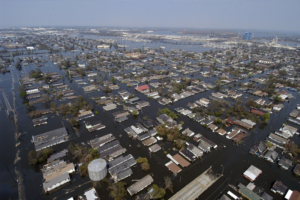Understanding and Mitigating Risk
 Environmental hazards and other risks cannot be avoided; however, their impact can be mitigated. We are all susceptible to risk – there are natural and human-caused risks in the places we live, work, and play. It is important to know and understand the hazards our communities are most vulnerable to so that we may be better prepared and help manage or reduce their impact.
Environmental hazards and other risks cannot be avoided; however, their impact can be mitigated. We are all susceptible to risk – there are natural and human-caused risks in the places we live, work, and play. It is important to know and understand the hazards our communities are most vulnerable to so that we may be better prepared and help manage or reduce their impact.
Addressing Uncertainty
Uncertainty and risk go hand in hand. We cannot plan for events or hazards that we are unaware of, nor can we mitigate potential risks to decrease the damage or harm they may inflict. Therefore, the first step to reduce risk is to identify it.
Within the last 20 years, the frequency and severity of extreme weather events has increased dramatically due to changes in the environment, and communities not historically impacted by extreme weather are now at risk. To address the threat of weather-related disasters and their uncertainty, it is critical communities understand the potential risks they face as well as the severity of each of these potentialities.
Every state has an emergency management office that is responsible for hazard mitigation planning to examine and address the state’s risk of natural and human-caused hazards. In turn, every locality within a state should carry out a risk assessment to understand, and if needed, further analyze information on current trends as well as historical data to identify specific risks—flooding, wildfires, hurricanes, earthquakes, biohazards, etc. A community’s geographic location and population will affect the kinds of risks it faces. Each risk may require a different plan or response to mitigate potential threats. Today, there are tools to help individuals, families and communities better understand their hazards and risks. Some states like California have their own pages or check out Columbia University’s Natural Hazard Index to learn more.
Planning and Preparing
Once a threat is identified and a thorough risk assessment performed, the planning process can begin. Disaster planning should be carried out at the local level and involve the whole community to ensure risks and prevention strategies are communicated effectively and address concerns regarding vulnerable populations, such as those with access and functional needs. Evacuation routes, alert systems, prevention measures, community sheltering, and the need for emergency kits should be routinely discussed at town halls or other community events. Risk information should be communicated in all languages spoken in a community and be available through multiple outlets as a lack of internet access and other communication means should be considered.
Although planning and preparing may begin at the community-level, individuals and families need to take steps to be better prepared in the event of an emergency. All households should have an emergency kit with a first aid, backup light (e.g., flashlights) and energy sources (e.g., solar or hand charger), batteries, personal sanitation items, as well as food, water and medicine to last for several days in the event of a disaster. Families need to have individual emergency plans in place to have insurance and important documents secured and ensure all family members know where to meet and how to communicate in the event they get separated or are not together when an emergency happens. Pets also need to be considered in supply and evacuation planning. Families and individuals can visit www.ready.gov to learn more and take steps today to start planning for a disaster or emergency.
Managing Risk to Build Resilience
Although disasters and emergencies cannot always be predicted, we can plan for them. Knowing and understanding what risks your community and family could face and taking action to prepare for and mitigate against them will not only make you and your community safer, it will save lives. Only through assessing, understanding, and then taking steps to mitigate risk will we build more resilient communities.




